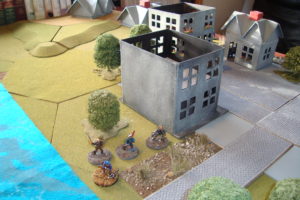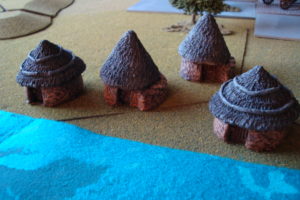Didn’t play last night, but did put together a Scenario Playsheet. Here’s a PDF copy.
Category Archives: Renaissance
Renaissance Skirmish – Actions
Played a repeat of the mounted scenario last night, incorporating the new thoughts on rules and use of dice to guide play.
Added “Quality” as a troop attribute, using “Excellent”, “Good”, “Average” and “Poor”. These classifications were assigned probability percentages of 75, 60, 50, and 40 percent, respectively. I also rolled a D4 to see how many individuals might have qualities that differed from the group. Another D4 to determine what that might be, with a roll of “4” being “Excellent”, a “3”, “Good” etc.
Final “Yes”, “No” roll was for awareness, which effected the ability to react in the first few turns of the game.
Turn 1: Blue had initiative, but was unaware, so Red entered at a trot.
Turn 2: Blue again had the initiative, became aware, with crossbowman moving to the road to shoot. Red accelerated to a gallop and entered into melee with the crossbowmen, with one bowman killed, and the other locked in melee with Red’s leader.
Turn 3: Death of the bowman did not effect Blue’s fear rating. Blue troops charged out of the house, surrounding the Red troopers. However, the troopers (excepting the leader locked in melee), simply charged through the swarm of their assailants. Red leader killed the other crossbowman.
Turn 4: Death of the second bowman increased Blue’s fear rating. Still having the initiative, Blue fled into the woods.
In retrospect, it was a bad move to move the crossbowman to the road. Should have waited. Still a quick and fun scenario. Another run-through tonight. Here’s a few photos.
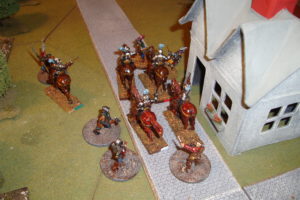
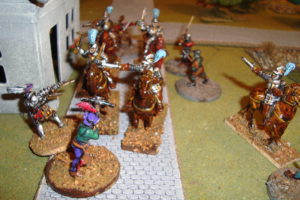
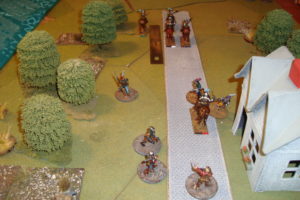
Renaissance Skirmish Rules – Resolution?
Out on the road for the past week. Long drives. Had some time to think about the skirmish rules.
Will stick with RAW’s basic framework but will rely on the dice to determine the probability of actions not covered, but intuitively needed.
The “Yes, No” dice will take care of questions such as “Can he fire this turn or must he reload?”, or “Is there a modification for this moving target?”, or “Can he add pistol to melee strength”.
Don’t want to bogged down in charts and modifiers. Will add gallop (walk, then trot, then gallop), but other than that. Just play the game and rely on common sense. Will see how it works.
Renassiance Skirmish – New Scenario, New Thoughts
Started another scenario last night.
It involved five of my recently mounted cavalry descending on a house being looted by seven infantry, two of which armed with crossbows.
Rolled for whether cavalry was moving at trot or gallop, and whether looters were aware of their approach and could then move during the first turn. Cavalry galloped and looters moved.
The cavalry charged into the village, with most of the looters running into the house. The two crossbowmen snapped off shots, one of which killed a horseman. A horseman shot the looters’ leader (who also fired – and missed – while remaining outside the house) but, wearing armor, survived with a saving throw.
The horsemen charged past the house, regrouped and turned. The crossbowmen could not turn and fire. The horsemen then rode once again past the house. During the exchange of fire the looters’ leader was killed.
I stopped at this point, overwhelmed by the number of situations in these few turns that are not addressed by RAW.
1) There is only one speed for horsemen.
2) No reloading time for missle weapons.
3) With RAW sequence, shooters that are not oriented towards targets cannot turn and shoot, or can they?
a) If not, how long does “turning” take?
4) What happens if a leader is killed? Quick rules read-thru twice, no answer.
5) Galloping horseman easy to kill as running human?
I fully understand that these rules are somewhat secondary to nautical and campaign considerations. However, I’m not working with those two aspects.
In short, wrong rules. Good framework – especially greed/fear as I have mentioned before. But not enough detail.
But how much? Ahhhhh, the eternal Grognard question. I have Donald Featherstone’s classic Skirmish Wargaming, as well as the earliest published version of The Sword and The Flame.
Sounds like a mash-up. Another try tonight, with a couple new concepts.
Renaissance Skirmish – Prep For New Scenario
Spent a few hours this week basing more Warhammer figures for skirmish encounters. More arquebusiers, a few blade weapons and some cavalry. Will use them for new scenarios.
Always nice to pull some derelict figures out of a semi-forgotten box, glue-on detached limbs, base and gloss coat.
Also prepped some figures for painting. Trying to expand the Red on Blue possibilities.
Renaissance Skirmish – Encounter Scenario
Thunderstorm activity forced the cancellation of today’s lake fishing expedition. So, up at 0530 with nowhere to go.
Gloomy, rainy weather was the perfect motivation to start working on the Renaissance Skirmish rules and scenarios.
Set up an encounter scenario using the same forces as last game, but with only a small building at a crossroads. I added an on-foot leader for Red, and a mounted leader for Blue.
Really had to resist promiscuously adding chrome to the On The Seven Seas rules. However, given the scenario, I had to use something for sight and spotting. Used 24 inches for unobstructed sighting, 12 inches into brush/rough and six inches into heavy cover (woods/forests). Roll for spotting at end of turn. Once within range, use the trusty Y/N/M dice to find out result. Once again, if result was a “Maybe”, then percentile dice above 50 percent for “Yes”, under for “No”.
For shooting, a D10 of 10 was a kill. Saving throw per RAW only if in cover or wearing armor.
Both Red and Blue forces assigned Greed and Fear ratings of 7 and 6, respectively. Rolled for alertness, and neither side was alert. This meant administrative formations moving down the road. Red from the North, Blue from the South. Red has three Arquebusiers, with Blue having three Crossbowmen.
Turn 1: Both sides move down the road.
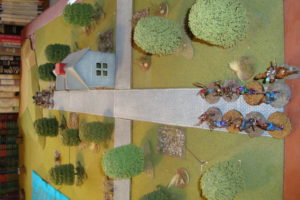
Turn 2: Both sides move down the road. Red sights Blue.
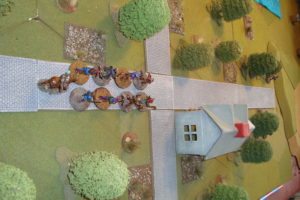
Turn 3: Red has I (Initiative). Red takes cover, Blue moves down the road.
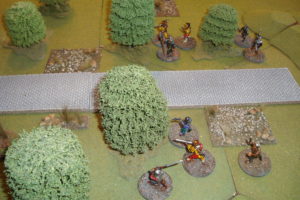
Turn 4: Blue has I, moves down the road. Red Arquebusiers move into firing ambush position.
Turn 5: Red has I, lies chilly. Blue sends two men to loot the house, remainder keep moving down the road.
Turn 6: Red has I. Stays in ambush position, Blue moves (luckily) just outside of firing range (6 inches for Arquebusiers).
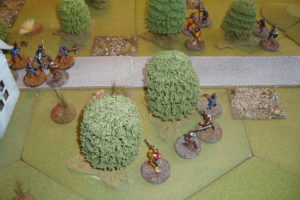
Turn 7: Red has I. This is very bad luck since they cannot shoot at Blue, and Blue can move within 6 inches and potentially spot the Red ambush, before being shot at. And, of course, Blue moves in and spots.
Turn 8: Red has I. Both sides exchange fire. No hits. Red moves into melee. Blue loses a Crossbowman and Swordsman. Red loses a Two-Handed Swordsman.
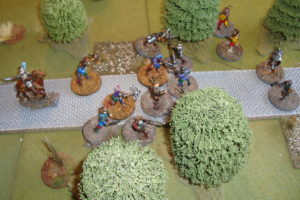
Turn 9: Blue rolls D10 four times (one each for casualties, two for ambush), no change in Fear rating! Red rolls once, no change. Blue has I. Melee continues as more Blues join the fray. Blue looters move out of the house advancing towards the melee. Blue loses one Swordsman.
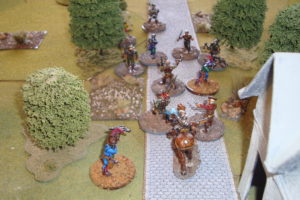
Turn 10: No change in Blue fear. Looters and Blue Leader join the melee. Blue Crossbowmen kill a Red Halbadier, and (with saving throw) force a Red Arquebusier back into the cover of the woods.
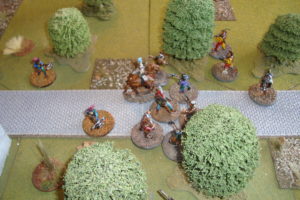
Turn 11: Red fear increases by one. Shooting ineffective. Red leader joins melee. No casualties.
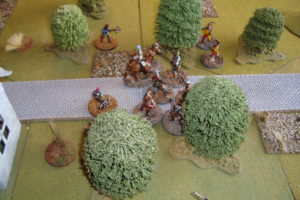
Shut it down at this point because it will be nothing but a Dice Fest. Blue has survived the ambush and it more than holding its own in the melee. So, what mechanism to break off contact?
Will run the same scenario again, but add rules for running, horse galloping, and use of pistol in melee. Have to consider the ineffectiveness of shooting despite the two “tens” rolled in Turn 10. Also, some type of reaction to orders/situations might be needed.
Regardless, a fun and quick game.
Renaissance Skirmish – End Game
Renaissance Skirmish – Moves 1-10
Finally started playing the game.
Scenario involved an attack on the village. Directional Die (DD) indicated the attack was to come from the Northeast, with the “Yes, No, Maybe” die (YNM) roll indicating the Defenders were not alert (If the result is a “Maybe”, I use two percentage dice, with result of 51% or more a “Yes”). This allowed the Attackers to move within 6 inches of the first building before another spotting attempt could be made.
Both sides had Greed and Fear ratings of 7, each. Rules As Written (RAW) state highest Greed has movement initiative, if tied roll for initiative. I decided to let the Attackers have the initiative until the turn after they were spotted, then work with RAW.
The Attackers included ten troops, three of which were armed with arquebuses. The Defenders totaled eight soldiers, three of which were armed with crossbows. Each soldier was assigned a number for identification and, in the case of the Defenders, which building they would occupy.
The game sequence is Spotting/Morale Check, Shooting, Movement, Melee.
Turn 1: Three attacking scouts moved to within 6 inches of the northern two-story house. Not spotted.
Turn 2: Scouts move to within 2 inches of the house. Spotted. Rolled 4-sided die to determine how many Defenders were in the house. Roll was for two defenders. Die roll indicated Defenders 1 and 3 (cutting weapons, one with pistol), and a YNM roll for each placed them both on the second floor.
Turn 3: Two Scouts enter house, Defender fires and misses with pistol.
Turn 4: One Scout moves upstairs, engages Defender. Draw.
Turn 5: Another Scout moves upstairs. Both Defenders engaged. One Attacker falls back, one Defender killed.
Turn 6: No change in Fear Level due to death of Defender. Main Body of attackers spotted by occupants of North single story building. Die roll results in it being defended by two Crossbowmen. Main Body advances after being signaled by Scout outside of two-story building. Melee continues in two-story house with both Attackers ganging up on the remaining swordsman. Defender is killed.
Turn 7-10: Defenders Fear Level increases by one due to death. Main Body continues to advance into the two-story house , with crossbowmen denied opportunity to shoot due to blocked line of site. Attacking arquebusiers occupy second floor.
Turn 11: Firefight between Arquebusiers and Crossbowmen. Realize nobody can make a hit because a D10 result of 10 is needed, and the houses have a minus modifier of two due to cover. Four Attackers move into single-story house. Engage defenders in melee. One Defender killed.
Turn 12: No change in Fear Level. Remaining four Defenders occupy West Two-Story House, with two in upper floor. Melee in single-story house continues. One Defender killed.
I stopped at this point and pondered the ineffectiveness of shooting. The quick fix is to make a D10 roll of 10 an automatic kill (no saving throws as per RAW). A D10 roll of 9 is a hit, with saving throw as per RAW (cover or armor). Shooter receives a +2 D10 mod if target is stationary. Will see how this works.
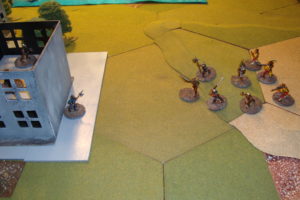
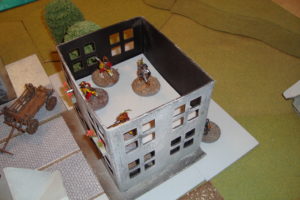
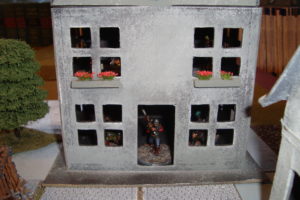
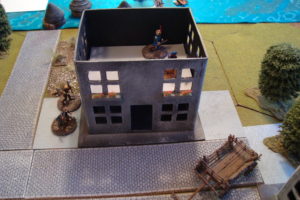
Modest Gains
OK, the 13 hour brisket cooking marathon (with accompanying beer consumption) got in the way of making progress with the Renaissance Skirmish. But have been hacking away at other projects.
Finished up my representational 15mm African Village structures for the East African Campaign. Here’s a quick shot.
Renaissance Skirmish – Initial Concepts
Ran through the rules last night using a few figures. Play is quick and straightforward.
Planning to use my random dice to generate the tactical situation for the scenario. The scenario parameters will include defender alertness, number of defenders outside of buildings etc. (whatever the etc is).
Will use directional dice to dictate where the attackers come from.
Next step is to determine the plan of attack.
When attackers within 8 inches (two moves) Yes/No/Maybe dice will determine if a building is occupied by defenders. A “Maybe” result will require another role with the building occupied if second roll is a Yes or Maybe.
A four-sided die will be used to determine how many defenders in a building. Once all defenders have been placed, any remaining buildings cannot be occupied except by defender movement during the scenario.
Should work for starters. Will give it a go over the weekend.
